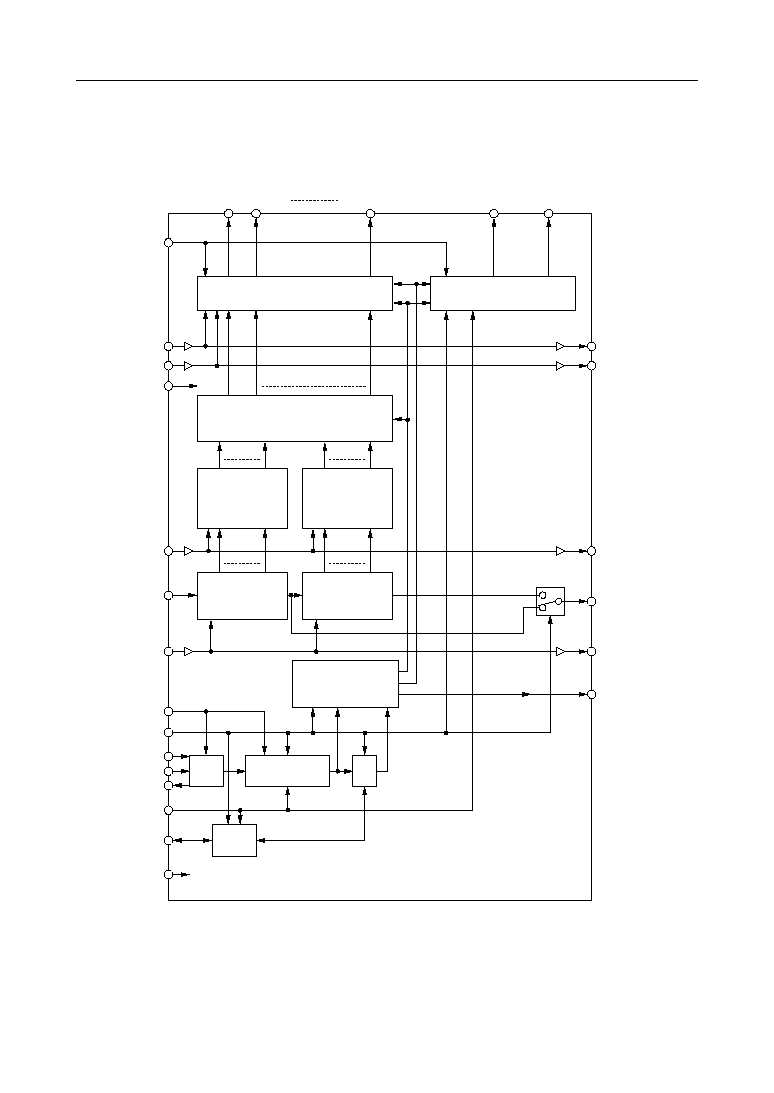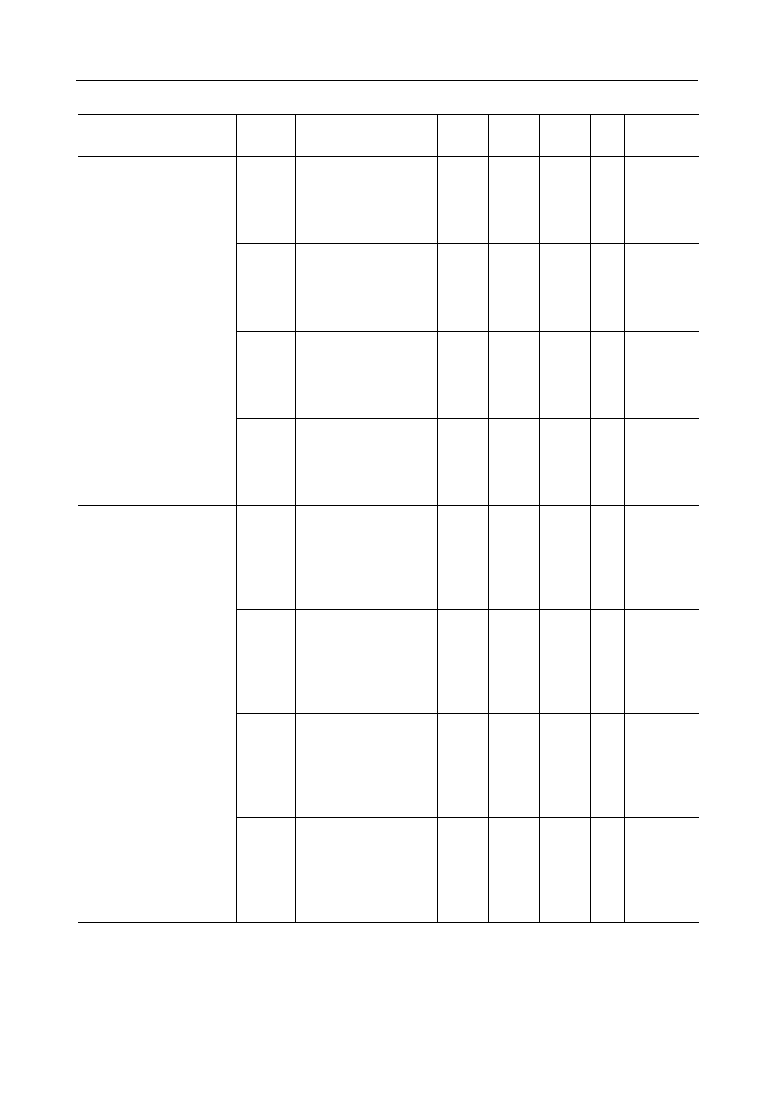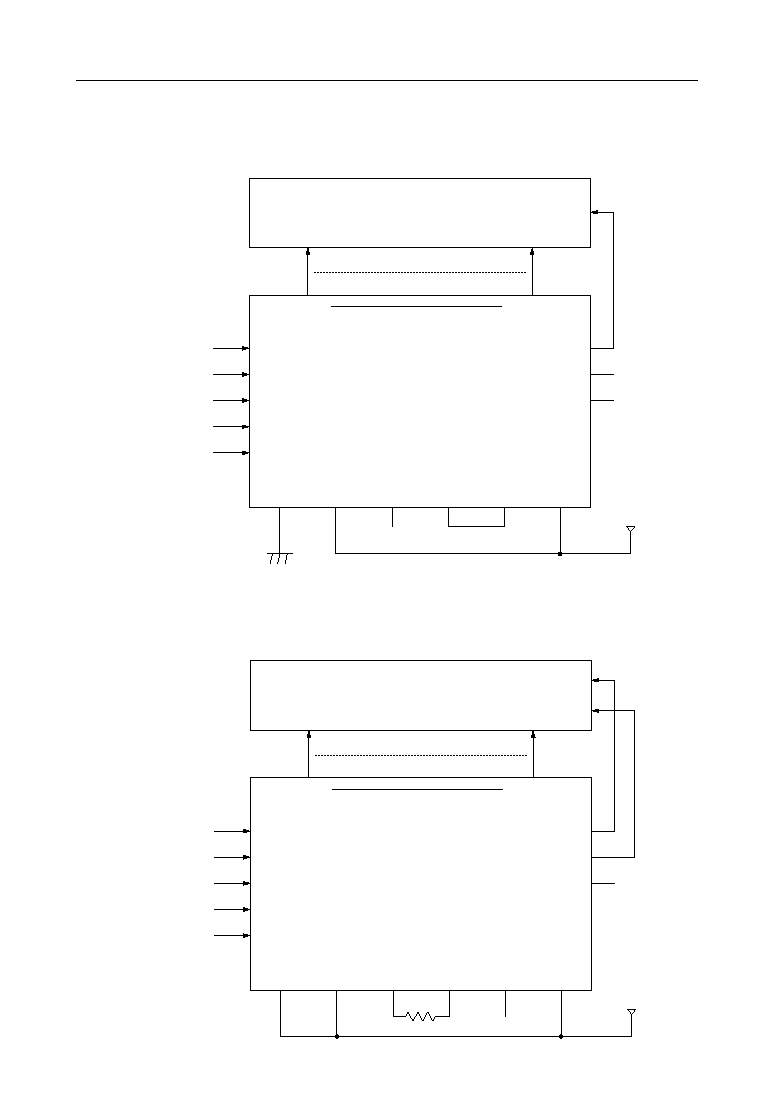 | –≠–ª–µ–∫—Ç—Ä–æ–Ω–Ω—ã–π –∫–æ–º–ø–æ–Ω–µ–Ω—Ç: ML9060 | –°–∫–∞—á–∞—Ç—å:  PDF PDF  ZIP ZIP |

ML9060
° Semiconductor
1/17
This version: Feb. 1999
GENERAL DESCRIPTION
The ML9060 consists of a 320-bit shift register, a 320-bit data latch, 160 sets of LCD drivers, and
a common signal generator circuit.
The LCD display data is input serially to the shift register from the DATA IN pin in
synchronization with the CLOCK IN signal, and is stored in the data latch by the LOAD IN
signal.
The LCD display data stored in the data latch is output via the LCD drivers.
A maximum of 160 segments of LCD can be driven in static display mode and a maximum of
320 segments can be driven directly in the 1/2 duty display mode.
It is possible to select the mode of using the internal oscillator circuit or the mode of using an
external clock for the common signal generator circuit. The ML9060 also outputs the sync signal
during the 1/2 duty display mode.
FEATURES
∑ Logic power supply
: 2.7 to 5.5V
∑ LCD Driving voltage
: 4.5 to 16V
∑ Maximum number of segments that can be driven:
Static display mode
: 160 segments
1/2 Duty display mode : 320 segments
∑ Serial transfer clock
: 1 MHz max.
∑ The microcontroller interface consists of the three signals DATA IN, CLOCK IN, and LOAD
IN.
∑ An RC oscillator circuit is built in which can use either an external resistor or the internal
resistor.
∑ Cascade connection of several ICs is possible.
∑ Built-in common signal generator circuit.
∑ Built-in common output mid-level voltage generator circuit.
∑ Input for turning all segments ON is available (SEG-TEST IN).
∑ Input for turning all segments OFF is available (BLANK IN).
∑ Gold bump chip
Product name: ML9060DVWA
° Semiconductor
ML9060
1/2 DUTY, 160-OUTPUT STATIC LCD DRIVER
E2B0051-19-22
Prelim
inary

ML9060
° Semiconductor
2/17
BLOCK DIAGRAM
SEG-TEST IN
SEG-TEST OUT
BLANK IN
BLANK OUT
V
DD
DATA IN
OSC2
OSC1
OSC I/E
M/S
SYNC
GND
Shift Register B
P0160b
P01b
SIb
SOb
Shift Register A
P0160a
P01a
SIa
SOa
LOAD IN
LOAD OUT
SEG160
SEG2
SEG1
CLOCK IN
CLOCK OUT
DATA OUT
Timing Generator
V
LCD
1/2VLCD Generator
& Common Drivers
COM B
COM A
COM OUT
D/S
OSCR
1/64 or 1/128
OSC
1/2
SYNC
Data Latch B
L0160b
L01b
LI160b
LI1b
Data Latch A
L0160a
L01a
LI160a
LI1a
Segment Drivers
Data Selector
DSI160b
DSI1b
DSI160a
DSI1a
DS0160
DS02
DS01

ML9060
° Semiconductor
3/17
*: Use with V
DD
V
LCD
Note: Never place a short between an output pin and another output pin or between an output
pin and other pins (input pins, I/O pins, or power supply pins).
ABSOLUTE MAXIMUM RATINGS
Parameter
Symbol
Condition
Rating
Unit
Logic power supply voltage
V
DD
≠0.3 to +6.5
LCD Driving voltage
V
LCD
0 to 18
Input voltage
V
I
GND≠0.3 to V
DD
+0.3
Storage temperature
T
STG
--
≠55 to +150
∞
C
Ta = 25
∞
C
Ta = 25
∞
C
Ta = 25
∞
C
V
V
V
RECOMMENDED OPERATING CONDITIONS
Parameter
Symbol
Condition
Range
Unit
Logic power supply voltage
V
DD
*
2.7 to 5.5
LCD Driving voltage
V
LCD
*
4.5 to 16
Operating temperature
T
op
--
≠40 to +85
∞C
--
--
V
V

ML9060
° Semiconductor
4/17
ELECTRICAL CHARACTERISTICS
DC Characteristics
"H" Input voltage
Parameter
Symbol
Condition
Min.
Typ.
Max.
Unit
Applicable pin
V
IH1
*1
0.7V
DD
--
V
DD
V
DATA IN
CLOCK IN
LOAD IN
SEG-TEST IN
BLANK IN
M/S, D/S
OSC1, OSC I/E
V
IH2
*2
--
0.8V
DD
--
V
DD
"L" Input voltage
V
IL1
*1
--
GND
--
0.3V
DD
V
V
IL2
*2
GND
--
0.2V
DD
Input leakage current 1
I
L1
V
I
= V
DD
or 0V
--
--
±
1.0
mA
Input leakage current 2
I
L2
V
I
= V
DD
or 0V
D/S = "H"
M/S = "L"
±
10
mA
SYNC
--
--
"H" Output
voltage
V
OHS
I
O
= ≠30mA
V
LCD
≠0.2
--
--
V
SEG1 to SEG160
V
OHC
*3
I
O
= ≠150mA
V
LCD
≠0.2
--
--
V
COM A, COM B
V
OHL1
I
O
= ≠100mA
0.9V
DD
V
DATA OUT
CLOCK OUT
LOAD OUT
SEG-TEST OUT
BLANK OUT
COM OUT
SYNC
--
--
V
OHL2
I
O
= ≠200mA
0.9V
DD
--
--
V
OSC2
"M" Output
voltage
V
OMC
*3 I
O
=
±
150mA
1/2V
LCD
≠0.15
1/2V
LCD
1/2V
LCD
+0.15
V
COM A, COM B
V
OLS
I
O
= 30mA
--
--
0.2
V
V
OLC
*3
I
O
= 150mA
--
--
0.2
V
DATA OUT
CLOCK OUT
LOAD OUT
SEG-TEST OUT
BLANK OUT
COM OUT
SYNC
V
OLL1
I
O
= 100mA
--
--
0.1V
DD
V
V
OLL2
I
O
= 200mA
--
--
0.1V
DD
V
OSC2
Output
resistance
R
SEG
--
--
10
kW
SEG1 to SEG160
R
COM
--
--
1.5
kW
COM A, COM B
Segment
Common
Logic
Common
Segment
Common
Logic
Segment
Common
SEG1 to SEG160
COM A, COM B
(VDD = 2.7 to 5.5V, VLCD = 4.5 to 16V, Ta = ≠40 to +85
∞
C)
"L" Output
voltage
"M": Middle level

ML9060
° Semiconductor
5/17
*1: Applicable to the DATA IN, LOAD IN, SEG-TEST IN, M/S, D/S, and OSC I/E pins.
*2: Applicable to the CLOCK IN, OSC1, and BLANK IN pins.
*3: Applicable to the voltage drop when the current flows into or out of one COM pin.
*4: The power supply current consumption will be determined finally at the end of sample
evaluations.
The LCD display data of "0" and "1" are input alternately.
Parameter
Symbol
Condition
Min.
Typ.
Max.
Unit
Applicable
pin
I
DDS1
--
--
TBD
mA
Static supply current *4
D/S = "L" (Static)
Fix other input levels
at either "H" or "L"
Oscillator stopped
No load
V
DD
I
DDS2
--
--
TBD
mA
D/S = "H" (1/2duty)
Fix other input levels
at either "H" or "L"
Oscillator stopped
No load
V
DD
I
LCDS1
--
--
TBD
mA
D/S = "L" (Static)
Fix other input levels
at either "H" or "L"
Oscillator stopped
No load
V
LCD
I
LCDS2
--
--
TBD
mA
D/S = "H" (1/2duty)
Fix other input levels
at either "H" or "L"
Oscillator stopped
No load
V
LCD
I
DD1
--
--
TBD
mA
Dynamic supply current *4
V
DD
= 5.5V
D/S = "L" (Static)
OSC1 is Open
OSC2 is connected to OSCR
Other inputs are "H" or "L"
No load
V
DD
I
DD2
--
--
TBD
mA
V
DD
= 5.5V
D/S = "H" (1/2duty)
OSC1 is Open
OSC2 is connected to OSCR
Other inputs are "H" or "L"
No load
V
DD
I
LCD1
--
--
TBD
mA
V
DD
= 5.5V
D/S = "L" (Static)
OSC1 is Open
OSC2 is connected to OSCR
Other inputs are "H" or "L"
No load
V
LCD
I
LCD2
--
--
TBD
mA
V
DD
= 5.5V
D/S = "H" (1/2duty)
OSC1 is Open
OSC2 is connected to OSCR
Other inputs are "H" or "L"
No load
V
LCD

ML9060
° Semiconductor
6/17
* : The specifications of the internal Rf clock frequency and the external Rf clock frequency will
be determined finally at the end of sample evaluations.
Switching Characteristics
Parameter
Symbol
Condition
Min. Typ. Max. Unit
Applicable pin
f
CP1
--
--
25.6 kHz
OSC IN Clock frequency
(external input)
The clock is input to the
OSC1 pin. The pins OSC2
and OSCR are left open.
OSC I/E = "L"
OSC1
(V
DD
= 2.7 to 5.5V, V
LCD
= 4.5 to 16V, Ta = ≠40 to +85
∞
C)
t
WCP1
50
--
--
µ
s
Clock pulse width
(external input)
OSC1
f
OSC1
7.7
12.8 20.5 kHz
External Rf clock
frequency
(internal oscillations)
An Rf of 120k W
±
2% is
connected between OSC1
and OSC2. OSCR is left
open. OSC I/E = 'H"
OSC1, OSC2
f
OSC2
7.7
12.8 20.5 kHz
Internal Rf clock frequency
(with the built-in oscillator)
OSC1 open. OSC2 and
OSCR shorted. OSC I/E
tied to V
DD
or any "H" level.
OSC1, OSCR,
OSC2
f
CP2
--
--
1
MHz
Data clock frequency
CLOCK IN
t
WCP2
100
--
--
ns
Data clock pulse width
CLOCK IN
t
SU
50
--
--
ns
Data setup time
DATA IN
t
HD
50
--
--
ns
Data hold time
CLOCK IN
t
CL
100
--
--
ns
CLOCK to LOAD
Period
CLOCK IN
t
LC
100
--
--
ns
LOAD to CLOCK
Period
LOAD IN
t
WLD
100
--
--
ns
LOAD Pulse width
LOAD IN
t
PLH
t
PHL
--
--
50
ns
CLOCK IN to
DATA OUT delay time
C
L
=15pF
CLOCK IN
DATA OUT
t
DIO
--
--
20
ns
IN to OUT delay time
No load
CLOCK IN/OUT
LOAD IN/OUT
SEG-TEST IN/OUT
BLANK IN/OUT
t
DCS
--
--
40
ns
COM OUT to SYNC
delay time
C
L
=15pF
COM OUT
SYNC
t
R
--
--
50
ns
Input signal rise time
All inputs other than
the OSCR input
t
F
--
--
50
ns
Input signal fall time

ML9060
° Semiconductor
7/17
TIMING DIAGRAM
OSC1
(External clock)
1/f
CP1
t
WCP1
t
WCP1
V
IH
V
IH
V
IL
V
IL
V
IH
V
IH
V
IL
V
IH
V
IL
DATA IN
CLOCK IN
V
IH
V
IH
V
IL
V
IL
V
IL
V
IL
LOAD IN
V
IH
V
IH
V
IL
V
IL
DATA OUT
V
OH
V
OL
t
WCP2
t
WCP2
t
HD
t
SU
1/f
CP2
t
CL
t
LC
t
WLD
t
PLH
t
PHL
CLOCK IN
LOAD IN
SEG-TEST IN
BLANK IN
V
IH
V
IL
CLOCK OUT
LOAD OUT
SEG-TEST OUT
BLANK OUT
All input signals
COM OUT
V
OH
V
OL
V
IH
V
IH
V
IL
V
IL
SYNC
1/2V
DD
1/2V
DD
1/2V
DD
1/2V
DD
t
DIO
t
DIO
t
R
t
F
t
DCS
t
DCS

ML9060
° Semiconductor
8/17
FUNCTIONAL DESCRIPTION
The ML9060 is an LCD driver LSI with an internal shift register and a set of internal data latches
and is capable of driving LCD displays of up to 320 segments either in the static mode or in the
1/2 duty mode. The display data is read into the shift register serially from the DATA IN pin
at the rising edge of the CLOCK IN input signal. The display data is transferred internally to
the data latches at the High level of the LOAD IN input signal and is output to the segments
via the segment drivers in this IC. The display data in the shift register is output via the DATA
OUT pin in synchronization with the falling edge of the CLOCK IN input signal. The display
data should be input in the sequence of SEG160, SEG159, ... , SEG2, SEG1 for proper display of
data.
Description of Pin Functions
∑ M/S
This is the input pin for selecting either the Master mode or the Slave mode. This LSI goes into
the master mode when this pin is High and enters the Slave mode when this pin is Low.
∑ D/S
This input pin is for selecting either the dynamic display mode at 1/2 duty (D mode - "H" input)
or the static display mode (S mode - "L" input).
Note that the internal bias resistor is made ON in the dynamic (D) mode and is turned OFF in
the static mode (S).
∑ OSC I/E
This is the input pin for selecting whether to use the external clock input mode, or the internal
Rf oscillation mode or the external Rf oscillation mode.
When this pin is tied to the "H" level, the internal Rf oscillation mode or the external Rf
oscillation is used. When this pin is tied to the "L" level, the external clock input is used for the
operation of the LSI.
In the slave mode of operation of this LSI, any input to this pin will be ignored. Hence, tie this
pin to V
DD
or GND in the slave mode.
∑ OSC1, OSCR, OSC2
These are the pins for the oscillator for generating the common signal.
In the Master mode (M/S pin = "H"):
It is possible to select from among the three modes - internal Rf oscillation mode, external Rf
oscillation mode, and the external clock input mode. During the static display operation mode,
a common signal with 1/128th the frequency of the clock oscillator is output via the COM OUT
pin.
During the 1/2 duty dynamic display operation mode, a common signal with 1/64th the
frequency of the clock oscillator is output via the COM OUT pin.
∑ Internal Rf oscillation mode: Tie the OSC I/E pin to "H", short the pins OSCR and OSC2, and
leave the pin OSC1 open.
∑ External Rf oscillation mode: Tie the OSC I/E pin to "L", connect an external resistor Rf
between the pins OSC1 and OSC2, and leave the pin OSCR open.
∑ External clock input mode: Tie the OSC I/E pin to "L", leave open the pins OSCR and OSC2,
and input the external clock signal to the pin OSC1.

ML9060
° Semiconductor
9/17
In the Slave mode (M/S pin = "L"):
Leave open the pins OSCR and OSC2 and connect the pin OSC1 to the COM OUT pin of the
ML9060 which has been set in the master mode. The common signal that is input to the pin OSC1
will be used as the internal common signal and is also output via a buffer from the COM OUT
pin.
∑ COM OUT
This is the common signal output pin. Connect this pin to the OSC1 pin of the ML9060 that is
set in the slave mode.
During operation in the master mode (M/S pin = "H") for static display, a common signal with
1/128th the frequency of the oscillator is output.
During operation in the master mode (M/S pin = "H") for 1/2 duty dynamic display, a common
signal with 1/64th the frequency of the oscillator is output.
During operation in the slave mode (M/S pin = "L"), the common signal that is input at the pin
OSC1 is output from this pin via a buffer.
∑ SYNC
This is the I/O pin for common signal synchronization.
This pin becomes the synchronization signal output pin during operation in the master mode
(M/S pin = "H") for 1/2 duty dynamic display.
This pin becomes the synchronization signal input pin during operation in the slave mode (M/
S pin = "H") for 1/2 duty dynamic display.
For cascade operation in the 1/2 duty display mode, connect the SYNC pins of all ML9060 ICs
used together.
During operation in the static display mode, this pin is tied to the "L" level inside the IC.
Connect this pin either to GND or leave it open.
∑ DATA IN
This is the display data input pin. Input the display data in the sequence of SEG160, SEG159,
... , SEG2, SEG1. The segment is turned ON when the display data is "H" and OFF when "L".
∑ DATA OUT
This is the display data output pin. During the static display mode of operation, the data of the
160th stage of the shift register is output from this pin. During the 1/2 duty dynamic display
mode, the data of the 320th stage of the shift register is output from this pin.
∑ CLOCK IN
This is the input pin for the shift clock of the display data. The display data that is input at the
DATA IN pin is input serially to the shift register at the rising edge of the CLOCK IN signal.
Also, the display data in the shift register is output from the DATA OUT pin at the falling edge
of the CLOCK IN signal.
∑ CLOCK OUT
This is the output pin for the shift clock of the display data. The shift clock signal that is input
to the CLOCK IN pin is output via a buffer from this pin.
∑ LOAD IN
This is the input pin for the display data load signal.
The display data in the shift register is output as such to the segment driver when this signal is
at the "H" level. When this signal is made "L", the shift register is isolated from the segment
drivers, and the display data of the shift register just before this pin goes "L" is retained in the
data latches and transfered to the segment drivers.

ML9060
° Semiconductor
10/17
∑ LOAD OUT
This is the output pin for the display data load signal. The load signal that is input to the LOAD
IN pin is output from this pin via a buffer.
∑ SEG-TEST IN
This is the input pin for making all segments ON. When this pin is "H", all segment outputs
(SEG1 to SEG160) become ON irrespective of the display data and the Blank signal. When this
pin is made "L", each of the segment outputs (SEG1 to SEG160) become ON or OFF according
to the display data.
∑ SEG-TEST OUT
This is the output pin for making all segments ON. The segment ON signal that is input to at
the SEG-TEST IN pin is output via a buffer.
∑ BLANK IN
This is the input pin for making all segments OFF. When this pin is "H", all segment outputs
(SEG1 to SEG160) become OFF irrespective of the display data. When this pin is made "L", each
of the segment outputs (SEG1 to SEG160) becomes ON or OFF according to the display data. The
BLANK IN is valid when the segment ON signal is "L".
∑ BLANK OUT
This is the output pin for making all segments OFF. The segment OFF signal that is input to the
BLANK IN pin is output via a buffer.
∑ SEG1 to SEG160
These are the signal outputs for driving the LCD segments and are connected to the corresponding
segment pins of the LCD panel.
During the Static mode of operation:
The SEGn output corresponds to bit n of the display data in the data latch A. The display data
in the data latch B becomes invalid. In the segment ON condition, a signal with a phase opposite
to that of the COM OUT signal is output from these pins. In the segment OFF condition, a signal
with a phase identical to that of the COM OUT signal is output from these pins.
During the 1/2 duty dynamic display mode of operation:
The SEGn output corresponds to bit n of the display data in the data latch A when COM A has
been selected and to bin n of the display data in the data latch B when COM B has been selected.
In the segment display ON condition, a signal opposite in phase to that of the selected COM
output is output from these pins. In the segment display OFF condition, a signal identical in
phase to that of the selected COM output is output from these pins.
∑ COM A, COM B
These are the outputs for LCD display and are connected to the common pins of the LCD panel.
During the Static mode of operation:
COM A and COM B both output a signal with the same phase as that of the COM OUT signal.

ML9060
° Semiconductor
11/17
During the 1/2 duty dynamic display mode of operation:
COM A and COM B change their states at every cycle of the COM OUT signal and repeat the
selected and non-selected modes always opposing each other in phase. A signal with the same
phase as that of the COM OUT signal is output in the selected mode. A voltage equal to 1/2V
LCD
is output in the non-selected mode.
When COM A is in the selected mode (that is, COM B is in the non-selected mode), the segment
outputs (SEG1 to SEG160) output signals corresponding to the display data in the data latch A.
When COM B is in the selected mode (that is, COM A is in the non-selected mode), the segment
outputs (SEG1 to SEG160) output signals corresponding to the display data in the data latch B.
∑ V
DD
This is the power supply input pin for the logic circuits.
∑ V
LCD
This is the power supply input pin for the LCD drivers.
∑ GND
This is the ground pin for all circuits.

ML9060
° Semiconductor
12/17
During the static display operation mode:
Segment Output and Common Output Waveforms
During the 1/2 duty display operation mode:
COM OUT
V
DD
GND
SYNC
V
DD
GND
COM A
Selected
COM B
Selected
COM A
Selected
COM B
Selected
COM A
V
LCD
1/2V
LCD
GND
COM B
V
LCD
1/2V
LCD
GND
V
LCD
GND
OFF
OFF
OFF
OFF
V
LCD
GND
OFF
ON
OFF
ON
V
LCD
GND
ON
OFF
ON
OFF
V
LCD
GND
ON
ON
ON
ON
Data latch A
Data latch B
Data latch A
Data latch B
SEGn
COM OUT
V
DD
GND
COM A
V
LCD
GND
COM B
V
LCD
GND
V
LCD
GND
OFF
OFF
OFF
OFF
V
LCD
GND
ON
ON
ON
ON
SEGn

ML9060
° Semiconductor
13/17
When a single ML9060 is used - 1/2 duty dynamic display mode (external Rf oscillation
mode)
APPLICATION CIRCUIT EXAMPLES
When a single ML9060 is used - Static display mode (internal Rf oscillation mode)
From the controller
ML9060
SEG-TEST IN
BLANK IN
LOAD IN
DATA IN
CLOCK IN
COM A
SYNC
LCD Panel 160 segments,
static display
D/S
M/S
OSC1
OSC2
OSCR
OSC I/E
open
V
DD
GND
or
open
SEG160
SEG1
COM
open
COM B
From the controller
ML9060
SEG-TEST IN
BLANK IN
LOAD IN
DATA IN
CLOCK IN
COM A
SYNC
LCD Panel 320 segments,
1/2 Duty dynamic display
D/S
M/S
OSC1
OSC2
OSCR
OSC I/E
open
V
DD
open
SEG160
SEG1
COM A
COM B
COM B
Rf

ML9060
° Semiconductor
14/17
Note: Take care about the resistance and capacitance of wiring for cascade connection.
Cascade Connection - Static display mode (external clock input mode)
From the controller
ML9060
SEG-TEST IN
BLANK IN
LOAD IN
DATA IN
CLOCK IN
D/S
M/S
OSC1 OSC2 OSCR OSC I/E
SEG-TEST OUT
BLANK OUT
LOAD OUT
DATA OUT
CLOCK OUT
COM OUT
SYNC
open
open
160
ML9060
SEG-TEST IN
BLANK IN
LOAD IN
DATA IN
CLOCK IN
D/S
M/S
OSC1 OSC2 OSCR OSC I/E
SEG-TEST OUT
BLANK OUT
LOAD OUT
DATA OUT
CLOCK OUT
COM OUT
SYNC
open
open
160
V
DD
or
GND
V
DD
open
COM A
COM A
open
LCD Panel (160 x n segments)
COM
Static
External clock
COM B
COM B
open
open
Note: Take care about the resistance and capacitance of wiring for cascade connection.
Cascade Connection - 1/2 duty dynamic display mode (internal Rf oscillation mode)
From the controller
ML9060
SEG-TEST IN
BLANK IN
LOAD IN
DATA IN
CLOCK IN
D/S
M/S
OSC1 OSC2 OSCR OSC I/E
SEG-TEST OUT
BLANK OUT
LOAD OUT
DATA OUT
CLOCK OUT
COM OUT
SYNC
open
160
ML9060
SEG-TEST IN
BLANK IN
LOAD IN
DATA IN
CLOCK IN
D/S
M/S
OSC1 OSC2 OSCR OSC I/E
SEG-TEST OUT
BLANK OUT
LOAD OUT
DATA OUT
CLOCK OUT
COM OUT
SYNC
open
open
160
V
DD
or
GND
V
DD
open
COM B
COM B
open
LCD Panel (320 x n segments)
COM B
1/2 duty dynamic display
COM A
COM A
open
COM A

ML9060
° Semiconductor
15/17
PAD CONFIGURATION
Pad layout (Pattern side)
Chip size
: 14.50 • 1.48mm
Chip thickness
: 625mm
±
30mm
Minimum bump pitch
: 80mm
Bump size
: 50 • 80
µ
m
Bump height
: 15mm
±
5
µ
m
Bump height inside the chip : max. ≠ min.
4
µ
m
Bump hardness
: max. 100 (HV: 25 g LOAD)
* : The substrate of the chip should either be connected to the GND level or be left open.
Pad Coordinates
204
37
1
26
Y
X
205
36
214
27
Pad No.
Y-coordinate
(
mm)
X-coordinate
(
mm)
Pad name
1
≠561
≠6680
NC
2
3
4
5
6
7
8
9
10
11
12
13
14
15
16
17
18
19
20
Pad No.
Y-coordinate
(
mm)
X-coordinate
(
mm)
Pad name
21
≠561
4008
OSC2
22
OSCR
23
OSC1
NC
NC
24
NC
25
26
27
28
29
30
31
32
33
34
35
36
≠6146
≠5611
≠5077
≠4542
≠4008
≠3474
≠2939
≠2405
≠1870
≠1336
≠802
≠267
267
NC
CLOCK IN
LOAD IN
SEG-TEST IN
BLANK IN
NC
NC
≠561
≠561
≠561
≠360
NC
NC
DATA IN
≠561
≠561
NC
SYNC
NC
COMOUT
NC
V
LCD
V
LCD
V
LCD
NC
GND
GND
GND
D/S
OSC I/E
M/S
V
DD
V
DD
V
DD
NC
802
1336
1870
2405
2939
3474
≠280
≠200
≠120
≠40
40
120
200
280
360
37
NC
561
38
NC
561
39
NC
561
40
COMA
561
≠561
4542
≠561
5077
≠561
5611
≠561
6146
≠561
6680
≠561
7121
≠561
7121
≠561
7121
≠561
7121
≠561
7121
≠561
7121
≠561
7121
≠561
7121
≠561
7121
≠561
7121
≠561
6680
≠561
6600
≠561
6520
≠561
6440
NC: No Connection

ML9060
° Semiconductor
16/17
Pad No.
Y-coordinate
(
mm)
X-coordinate
(
mm)
Pad name
41
561
6360
COM B
42
43
44
45
46
47
48
49
50
51
52
53
54
55
56
57
58
59
60
Pad No.
Y-coordinate
(
mm)
X-coordinate
(
mm)
Pad name
86
561
2760
SEG45
87
88
89
90
91
92
93
94
95
96
97
98
99
100
101
6280
6200
6120
6040
5960
5880
5800
5720
5640
5560
5480
5400
5320
5240
5160
5080
5000
4920
4840
102
103
104
105
2680
2600
2520
2440
2360
2280
2200
2120
2040
1960
1880
1800
1720
1640
1560
1480
1400
1320
1240
561
SEG1
561
SEG46
561
SEG2
561
SEG47
561
SEG3
561
SEG48
561
SEG4
561
SEG49
561
SEG5
561
SEG50
561
SEG6
561
SEG51
561
SEG7
561
SEG52
561
SEG8
561
SEG53
561
SEG9
561
SEG54
561
SEG10
561
SEG55
561
SEG11
561
SEG56
561
SEG12
561
SEG57
561
SEG13
561
SEG58
561
SEG14
561
SEG59
561
SEG15
561
SEG60
561
SEG16
561
SEG61
561
SEG17
561
SEG62
561
SEG18
561
SEG63
561
SEG19
561
SEG64
61
62
63
64
65
67
68
69
70
106
107
108
109
110
4760
4680
4600
4520
4440
4280
4200
4120
4040
112
113
114
115
1160
1080
1000
920
840
680
600
520
440
561
SEG20
561
SEG65
561
SEG21
561
SEG66
561
SEG22
561
SEG67
561
SEG23
561
SEG68
561
SEG24
561
SEG69
561
SEG26
561
SEG71
561
SEG27
561
SEG72
561
SEG28
561
SEG73
561
SEG29
561
SEG74
71
72
73
74
75
76
77
78
79
80
116
117
118
119
120
121
3960
3880
3800
3720
3640
3560
3480
3400
3320
3240
122
123
124
125
360
280
200
120
40
≠40
≠120
≠200
≠280
≠360
561
SEG30
561
SEG75
561
SEG31
561
SEG76
561
SEG32
561
SEG77
561
SEG33
561
SEG78
561
SEG34
561
SEG79
561
SEG35
561
SEG80
561
SEG36
561
SEG81
561
SEG37
561
SEG82
561
SEG38
561
SEG83
561
SEG39
561
SEG84
81
82
83
84
85
126
3160
3080
3000
2920
2840
127
128
129
130
≠440
≠520
≠600
≠680
≠760
561
SEG40
561
SEG85
561
SEG41
561
SEG86
561
SEG42
561
SEG87
561
SEG43
561
SEG88
561
SEG44
561
SEG89
66
111
4360
760
561
SEG25
561
SEG70

ML9060
° Semiconductor
17/17
Pad No.
Y-coordinate
(
mm)
X-coordinate
(
mm)
Pad name
131
561
≠840
SEG90
132
133
134
135
136
137
138
139
140
141
142
143
144
145
146
147
148
149
150
Pad No.
Y-coordinate
(
mm)
X-coordinate
(
mm)
Pad name
176
561
≠4440
SEG135
177
178
179
180
181
182
183
184
185
186
187
188
189
190
191
≠920
≠1000
≠1080
≠1160
≠1240
≠1320
≠1400
≠1480
≠1560
≠1640
≠1720
≠1800
≠1880
≠1960
≠2040
≠2120
≠2200
≠2280
≠2360
192
193
194
195
≠4520
≠4600
≠4680
≠4760
≠4840
≠4920
≠5000
≠5080
≠5160
≠5240
≠5320
≠5400
≠5480
≠5560
≠5640
≠5720
≠5800
≠5880
≠5960
561
SEG91
561
SEG136
561
SEG92
561
SEG137
561
SEG93
561
SEG138
561
SEG94
561
SEG139
561
SEG95
561
SEG140
561
SEG96
561
SEG141
561
SEG97
561
SEG142
561
SEG98
561
SEG143
561
SEG99
561
SEG144
561
SEG100
561
SEG145
561
SEG101
561
SEG146
561
SEG102
561
SEG147
561
SEG103
561
SEG148
561
SEG104
561
SEG149
561
SEG105
561
SEG150
561
SEG106
561
SEG151
561
SEG107
561
SEG152
561
SEG108
561
SEG153
561
SEG109
561
SEG154
151
152
153
154
155
157
158
159
160
196
197
198
199
200
≠2440
≠2520
≠2600
≠2680
≠2760
≠2920
≠3000
≠3080
≠3160
202
203
204
205
≠6040
≠6120
≠6200
≠6280
≠6360
≠6520
≠6600
≠6680
≠7121
561
SEG110
561
SEG155
561
SEG111
561
SEG156
561
SEG112
561
SEG157
561
SEG113
561
SEG158
561
SEG114
561
SEG159
561
SEG116
561
NC
561
SEG117
561
NC
561
SEG118
561
NC
561
SEG119
360
NC
161
162
163
164
165
166
167
168
169
170
206
207
208
209
210
211
≠3240
≠3320
≠3400
≠3480
≠3560
≠3640
≠3720
≠3800
≠3880
≠3960
212
213
214
≠7121
≠7121
≠7121
≠7121
≠7121
≠7121
≠7121
≠7121
≠7121
561
SEG120
280
NC
561
SEG121
200
BLANKOUT
561
SEG122
120
SEG-TESTOUT
561
SEG123
40
LOADOUT
561
SEG124
≠40
CLOCKOUT
561
SEG125
≠120
NC
561
SEG126
≠200
DATAOUT
561
SEG127
≠280
NC
561
SEG128
≠360
NC
561
SEG129
171
172
173
174
175
≠4040
≠4120
≠4200
≠4280
≠4360
561
SEG130
561
SEG131
561
SEG132
561
SEG133
561
SEG134
156
201
≠2840
≠6440
561
SEG115
561
SEG160

NOTICE
1.
The information contained herein can change without notice owing to product and/or
technical improvements. Before using the product, please make sure that the information
being referred to is up-to-date.
2.
The outline of action and examples for application circuits described herein have been
chosen as an explanation for the standard action and performance of the product. When
planning to use the product, please ensure that the external conditions are reflected in the
actual circuit, assembly, and program designs.
3.
When designing your product, please use our product below the specified maximum
ratings and within the specified operating ranges including, but not limited to, operating
voltage, power dissipation, and operating temperature.
4.
Oki assumes no responsibility or liability whatsoever for any failure or unusual or
unexpected operation resulting from misuse, neglect, improper installation, repair, alteration
or accident, improper handling, or unusual physical or electrical stress including, but not
limited to, exposure to parameters beyond the specified maximum ratings or operation
outside the specified operating range.
5.
Neither indemnity against nor license of a third party's industrial and intellectual property
right, etc. is granted by us in connection with the use of the product and/or the information
and drawings contained herein. No responsibility is assumed by us for any infringement
of a third party's right which may result from the use thereof.
6.
The products listed in this document are intended for use in general electronics equipment
for commercial applications (e.g., office automation, communication equipment,
measurement equipment, consumer electronics, etc.). These products are not authorized
for use in any system or application that requires special or enhanced quality and reliability
characteristics nor in any system or application where the failure of such system or
application may result in the loss or damage of property, or death or injury to humans.
Such applications include, but are not limited to, traffic and automotive equipment, safety
devices, aerospace equipment, nuclear power control, medical equipment, and life-support
systems.
7.
Certain products in this document may need government approval before they can be
exported to particular countries. The purchaser assumes the responsibility of determining
the legality of export of these products and will take appropriate and necessary steps at their
own expense for these.
8.
No part of the contents cotained herein may be reprinted or reproduced without our prior
permission.
9.
MS-DOS is a registered trademark of Microsoft Corporation.
Copyright 1999 Oki Electric Industry Co., Ltd.
Printed in Japan
E2Y0002-29-11

















